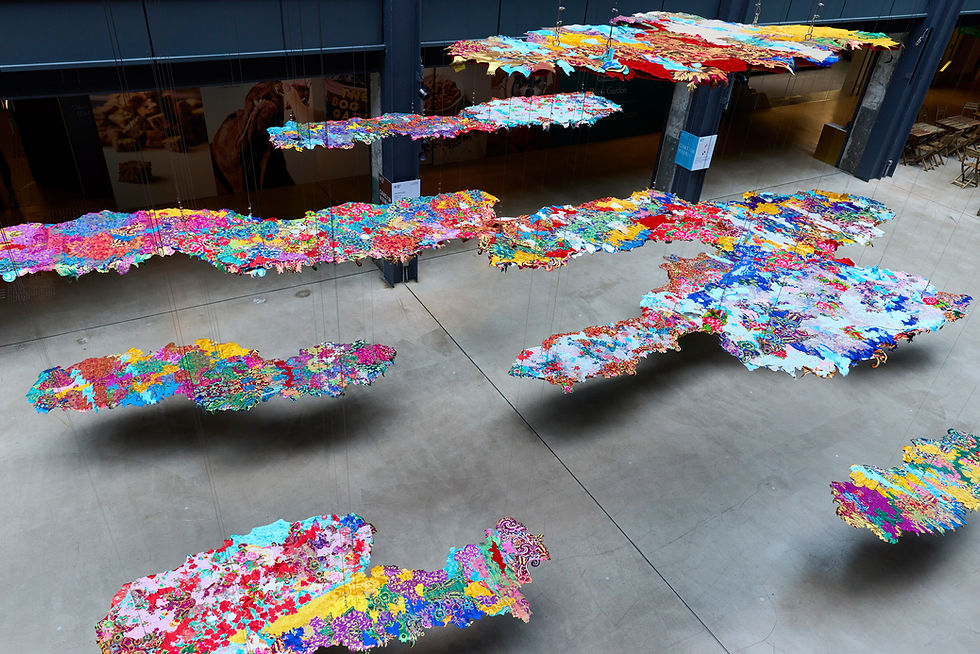The Philosophy of Seitaro Kuroda “To draw is to try to understand life”
- Nov 9, 2022
- 4 min read
Seitaro Kuroda was born in 1939 in Osaka. In 1961, he began working at the Yoshio Hayakawa Design Office. From 1966 to 1969, he lived in New York. When he returned to Japan, he founded the design office K2 with Keisuke Nagatomo. Now, he is based in Kitakyushu City in Fukuoka Prefecture, where his atelier is located, and is active as a painter, illustrator, and graphic designer.

The Greatest Joy: Making Art to Discover Why He Likes Making Art
Kuroda is an energetic artist, his activities ranging from live painting performances to painting murals, creative workshops, and hospital art, both in Japan and overseas.
“Sometimes people ask me, ‘Why do you do so much?’ The answer is simple — I just love making art more than anything else. If you ask me why I like drawing, I couldn’t tell you exactly. In fact, that’s what I’d like to find out.”
He says he is drawing even while having this interview. “It’s always interesting,” he continues.
“Some ways of making artwork, like teaming up with an art dealer to make something that sells — I don’t think that’s interesting. I’ve been an artist for 50 years now, so it’s not as if I don’t know how the artists’ world goes round, but I don’t want to know about any of that. I want to focus just on the feeling that drawing is exciting, and keep it at that.”
Kuroda approaches each of his artworks one at a time, but his creative process also involves interactions with many artists and people of culture.

“Yes, I can draw”: The Eureka Moment
“First of all, a painting isn’t something you can make all by yourself, is it?” Kuroda points out. “I’ve been fortunate with meeting people,” he adds in a warm, gentle tone. “I was also lucky that I’ve always been a fan of Akiyuki Nosaka.”
Turning Nosaka’s book A Collection of War Fairy Tales (Sensō dōwa shu) into a picture book and adapting it for film left a deep impression on Kuroda.
“A Collection of War Fairy Tales is about life. All animals except humans only hunt other animals in order to eat. Why do humans kill each other in war? A human is merely a living creature that is born, then dies. That’s what Nosaka-san tells us.”
Kuroda was 52 years old when he came across Nosaka’s book. “At the time, I heard the then-prime minister Keizo Obuchi announce, ‘50 years have passed since the war. Let’s start talking about other topics than war.’ I wondered, ‘Why?’ Right around then, I stumbled across Nosaka-san’s A Collection of War Fairy Tales at the Kinokuniya bookshop in New York.”
Back then, Kuroda was working at a school where students included the children of United Nations personnel. When he asked the elementary school students whether they are learning about war, they replied, “Of course.”
Kuroda felt concerned that “if things keep going at this rate, children in Japan might grow up without ever learning about war.” That was when Nosaka’s War Fairy Tales came to his mind, and an idea hit him like a revelation.
“A signal came to me, somewhere in my body, telling me to ‘turn it into a picture book’. I thought, ‘That’s right, I can draw.’”
Then in 1955, the Great Hanshin Earthquake occurred. “It was a major disaster, a life or death situation. Nosaka-san and I went to the affected areas. Because it was a matter of life.” Nosaka had a profound influence on Kuroda’s way of thinking about life and things in general.
“Now, I understand drawing pictures and performing music as an act to try to understand life,” says Kuroda. When asked what else he is engrossed in, he answers, “Living.”
Nature Teaches Us about Art and Music
Live painting is part of his life’s work, and Kuroda wants to convey the joy of drawing to children through his performances.
“I hope to give them an opportunity to discover just how fun art and music is,” he explains. “My commitment to this shares common ground with what I said about art, that ‘to draw is to try to understand life.’”
He continues, “When I observe nature closely, I can’t help but feel that it’s teaching us about art and music. Even now, when I look up, I see the mountains on the opposite bank, and the dense, towering cloud spreading beyond them. And beyond that there’s the Kanmon Straits with the Kanmon Bridge over it, said to be one of the most prominent bridges in Japan — but even that, to me, looks weak and feeble.”
“Without the sun, we can’t see anything. In painting, we use colours that we’ve learnt from the seven colours of the rainbow that the sun creates. Musical scores are made by the sensual perception of sounds in nature, like the wind or the waves. No matter how great the artist, every piece of art is born of nature. I hope to talk to the children about things like that,” he concludes.
Kuroda’s artwork, like an ode to humanity, shines with the brilliance of life. Our conversation with him made us realise how his art springs from his own sensibility and philosophy that hold a steadfast respect for nature and human beings.









